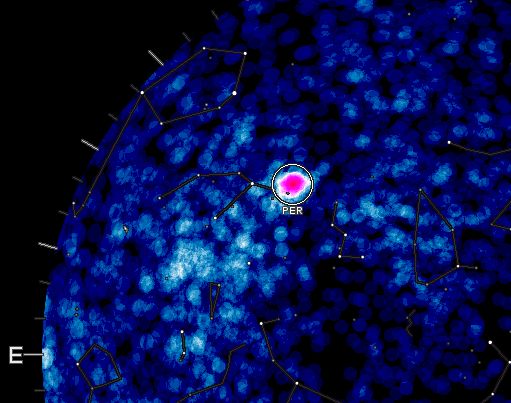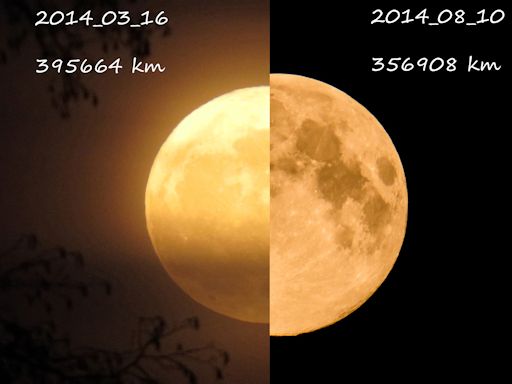New from Spaceweather.com: Edge of Space Advertising. Send your product or message to the edge of space for a down-to-Earth fee. Profits support student space weather research. Email Dr. Tony Phillips for more information. | | |
COMET COULD SPARK AURORAS ON MARS: Comet Siding Spring is about to fly historically close to Mars. The encounter could spark Martian auroras, a meteor shower, and other unpredictable effects. Whatever happens, NASA's fleet of Mars satellites will have a ringside seat. Get the full story and a video from Science@NASA.
PERSEID METEOR SHOWER: The annual Perseid meteor shower peaks tonight, Aug. 12-13, as Earth passes through a stream of debris from Comet Swift-Tuttle. Forecasters expect peak rates of 30 to 40 meteors per hour, less than usual because of the glare from the waning supermoon. Observing tips: To reduce the effects of moonlight, pick an observing site with clear, dry air. Also try watching the sky from the moonshadow of a tall building or other obstacle. Many Perseid fireballs will be visible in spite of the glare. [NASA chat]
Unaffected by moonlight, the Canadian Meteor Orbit Radar (CMOR) is scanning the skies above North America for echoes from disintegrating meteoroids. The latest CMOR sky map shows strong activity from the constellation Perseus (PER):

Click to view a radar map of the entire sky. The Perseids are not alone. In the southern hemisphere, a cluster of lesser radiants is also active. Foremost among them is the Southern Delta Aquarids (SDA) probably caused by debris from Comet 96P/Machholz. Delta Aquarid fireballs will augment the Perseids south of the equator.
Because of the moonlight, radar may be the best way to observe tonight's shower. You can listen to meteor radar echoes in realtime on Space Weather Radio.
Realtime Meteor Photo Gallery
WEEKEND SUPERMOON: The full Moon of August 10th was as much as 14% bigger and 30% brighter than other full Moons of the year. Some say that makes it a supermoon. Others retort that it's really not as super as the media has made it out to be. Who's correct? Vesa Vauhkonen of Rautalampi, Finland, took a stab at settling the question with this side-by-side comparison:

"I compared the normal full Moon of March 2014 with the Supermoon of Aug 2014," says Vauhkonen. "In individual images, the difference in size might be difficult to see, but putting them side by side makes the difference clear. I used the same photo settings for both images, so the scaling has no errors."
Supermoons are possible because the Moon's orbit is not a circle, it is an ellipse. One side, perigee, is 50,000 km closer than the other, apogee. On August 10th the Moon became full just as it reached perigee, the point closest to Earth. This caused the Moon to appear authentically bigger and brighter than usual.
More photos of the full Moon, and the landscape of Earth bathed in super-moonlight, may be found in the realtime photo gallery:
Realtime Space Weather Photo Gallery
Realtime Comet Photo Gallery
Realtime Aurora Photo Gallery
Realtime NLC Photo Gallery
Every night, a network of NASA all-sky cameras scans the skies above the United States for meteoritic fireballs. Automated software maintained by NASA's Meteoroid Environment Office calculates their orbits, velocity, penetration depth in Earth's atmosphere and many other characteristics. Daily results are presented here on Spaceweather.com.
On Aug. 12, 2014, the network reported 48 fireballs.
(37 sporadics, 11 Perseids)

In this diagram of the inner solar system, all of the fireball orbits intersect at a single point--Earth. The orbits are color-coded by velocity, from slow (red) to fast (blue). [Larger image] [movies]
Potentially Hazardous Asteroids (
PHAs) are space rocks larger than approximately 100m that can come closer to Earth than 0.05 AU. None of the known PHAs is on a collision course with our planet, although astronomers are finding
new ones all the time.
On August 12, 2014 there were potentially hazardous asteroids.
Notes: LD means "Lunar Distance." 1 LD = 384,401 km, the distance between Earth and the Moon. 1 LD also equals 0.00256 AU. MAG is the visual magnitude of the asteroid on the date of closest approach. | | The official U.S. government space weather bureau |
| | The first place to look for information about sundogs, pillars, rainbows and related phenomena. |
| | Researchers call it a "Hubble for the sun." SDO is the most advanced solar observatory ever. |
| | 3D views of the sun from NASA's Solar and Terrestrial Relations Observatory |
| | Realtime and archival images of the Sun from SOHO. |
| | from the NOAA Space Environment Center |
| | the underlying science of space weather |

